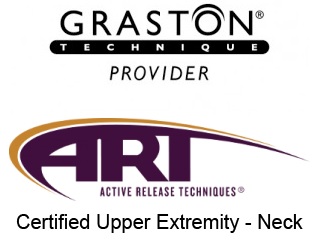Myofascial Release & CranioSacral Therapy
Myofascial release (MFR) is a manual therapy technique that treats skeletal muscle immobility and pain by relaxing contracted muscles, improving blood and lymphatic circulation, and stimulating the stretch reflex in muscles.
Fascia is a thin, tough, elastic type of connective tissue that wraps most structures within the human body, including muscle, tendons, organs, and nerves. Fascia supports and protects these structures. Osteopathic theory proposes that this soft tissue can become restricted due to psychogenic disease, overuse, trauma, infectious agents, or inactivity, often resulting in pain, muscle tension, and corresponding diminished blood flow.
Myofascial release is a type of physical therapy massage often used to treat chronic pain, myofascial pain syndrome, and conditions like fibromyalgia. Myofascial pain syndrome is a chronic pain disorder caused by sensitivity and tightness in myofascial tissues. These tissues surround and support the muscles throughout the body. The pain usually originates from specific points within the myofascial tissues called “trigger points.” However, adhesions and fibrosis within the fascial system also cause pain and dysfunction. Myofascial release focuses on reducing pain by easing the tension and tightness in the trigger points and breaking up adhesions and fibrosis.
Craniosacral Therapy (CST) is a gentle, hands-on method of evaluating and enhancing the functioning of a physiological body system called the craniosacral system – comprised of the membranes and cerebrospinal fluid that surround and protect the brain and spinal cord.
Using a soft touch generally no greater than 5 grams, or about the weight of a nickel, practitioners release restrictions in the craniosacral system to improve the functioning of the central nervous system.
The Craniosacral System is a semi-closed hydraulic system contained within a tough waterproof membrane, the Dura Mater, which envelops the brain and the spinal cord. An important function of this system is the production, circulation, and reabsorption of Cerebrospinal Fluid (CSF). CSF is produced within the Craniosacral System and maintains the physiological environment in which your brain and nervous system develop, live, and function. The production and reabsorption of CSF within the Dura Mater produces a continuous rise and fall of fluid pressure. It is this rise and fall of fluid pressure that constitutes the Craniosacral rhythm perceivable by a skilled therapist in the movement of cranial bones and throughout the body. The craniosacral rhythm, like the cardiac and respiratory pulse, can be felt throughout the body and used to monitor the function of the craniosacral system and the health of the body.
By complementing the body’s natural healing processes, CST is increasingly used as a preventive health measure for its ability to bolster resistance to disease and is effective for a wide range of medical problems associated with pain and dysfunction, including:
- Migraine Headaches
- Chronic Neck and Back Pain
- Motor-Coordination Impairments
- Central Nervous System Disorders
- Orthopedic Problems
- Concussions and Traumatic Brain Injuries
- Stress and Tension-Related Problems
- Fibromyalgia and other Connective-Tissue Disorders
- Temporomandibular Joint Syndrome (TMJ)
- Neurovascular or Immune Disorders

